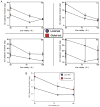Shared attentional resources for global and local motion processing
- PMID: 17997679
- PMCID: PMC3849404
- DOI: 10.1167/7.10.10
Shared attentional resources for global and local motion processing
Abstract
One of the most important aspects of visual attention is its flexibility; our attentional "window" can be tuned to different spatial scales, allowing us to perceive large-scale global patterns and local features effortlessly. We investigated whether the perception of global and local motion competes for a common attentional resource. Subjects viewed arrays of individual moving Gabors that group to produce a global motion percept when subjects attended globally. When subjects attended locally, on the other hand, they could identify the direction of individual uncrowded Gabors. Subjects were required to devote their attention toward either scale of motion or divide it between global and local scales. We measured direction discrimination as a function of the validity of a precue, which was varied in opposite directions for global and local motion such that when the precue was valid for global motion, it was invalid for local motion and vice versa. There was a trade-off between global and local motion thresholds, such that increasing the validity of precues at one spatial scale simultaneously reduced thresholds at that spatial scale but increased thresholds at the other spatial scale. In a second experiment, we found a similar pattern of results for static-oriented Gabors: Attending to local orientation information impaired the subjects' ability to perceive globally defined orientation and vice versa. Thresholds were higher for orientation compared to motion, however, suggesting that motion discrimination in the first experiment was not driven by orientation information alone but by motion-specific processing. The results of these experiments demonstrate that a shared attentional resource flexibly moves between different spatial scales and allows for the perception of both local and global image features, whether these features are defined by motion or orientation.
Figures






Similar articles
-
Simultaneous encoding of direction at a local and global scale.Percept Psychophys. 1998 Feb;60(2):191-200. doi: 10.3758/bf03206028. Percept Psychophys. 1998. PMID: 9529903
-
Distinct position assignment mechanisms revealed by cross-order motion.Vision Res. 2008 Sep;48(21):2260-8. doi: 10.1016/j.visres.2008.07.001. Epub 2008 Aug 15. Vision Res. 2008. PMID: 18675290
-
Pooling and segmenting motion signals.Vision Res. 2009 Jun;49(10):1065-72. doi: 10.1016/j.visres.2008.10.024. Epub 2008 Dec 16. Vision Res. 2009. PMID: 19027034
-
Motion perception in global versus local attentional modes.Aust N Z J Ophthalmol. 1998 May;26 Suppl 1:S114-6. doi: 10.1111/j.1442-9071.1998.tb01357.x. Aust N Z J Ophthalmol. 1998. PMID: 9685042
-
Attention modulates perception of transparent motion.Vision Res. 2005 Sep;45(19):2587-99. doi: 10.1016/j.visres.2005.03.004. Epub 2005 Apr 20. Vision Res. 2005. PMID: 16022880
Cited by
-
Multiple object tracking in autism spectrum disorders.J Autism Dev Disord. 2013 Jun;43(6):1394-405. doi: 10.1007/s10803-012-1694-6. J Autism Dev Disord. 2013. PMID: 23104619 Free PMC article.
-
Reexamining the possible benefits of visual crowding: dissociating crowding from ensemble percepts.Atten Percept Psychophys. 2011 May;73(4):1003-9. doi: 10.3758/s13414-010-0086-2. Atten Percept Psychophys. 2011. PMID: 21305370 Free PMC article.
-
The psychophysics of visual motion and global form processing in autism.Brain. 2010 Feb;133(Pt 2):599-610. doi: 10.1093/brain/awp272. Epub 2009 Nov 3. Brain. 2010. PMID: 19887505 Free PMC article.
-
Efficient summary statistical representation when change localization fails.Psychon Bull Rev. 2011 Oct;18(5):855-9. doi: 10.3758/s13423-011-0125-6. Psychon Bull Rev. 2011. PMID: 21748419 Free PMC article.
-
Action and attentional load can influence aperture effects on motion perception.Exp Brain Res. 2011 Mar;209(2):215-24. doi: 10.1007/s00221-011-2537-y. Epub 2011 Jan 26. Exp Brain Res. 2011. PMID: 21267553
References
-
- Adelson EH, Movshon JA. Phenomenal coherence of moving visual patterns. Nature. 1982;300:523–525. - PubMed
-
- Aghdaee SM. Adaptation to spiral motion in crowding condition. Perception. 2005;34:155–162. - PubMed
-
- Aghdaee SM, Zandvakili A. Adaptation to spiral motion: Global but not local motion detectors are modulated by attention. Vision Research. 2005;45:1099–1105. - PubMed
-
- Bex PJ, Dakin SC. Spatial interference among moving targets. Vision Research. 2005;45:1385–1398. - PubMed
-
- Braddick O. Segmentation versus integration in visual motion processing. Trends in Neurosciences. 1993;16:263–268. - PubMed
MeSH terms
Grants and funding
LinkOut - more resources
Full Text Sources

